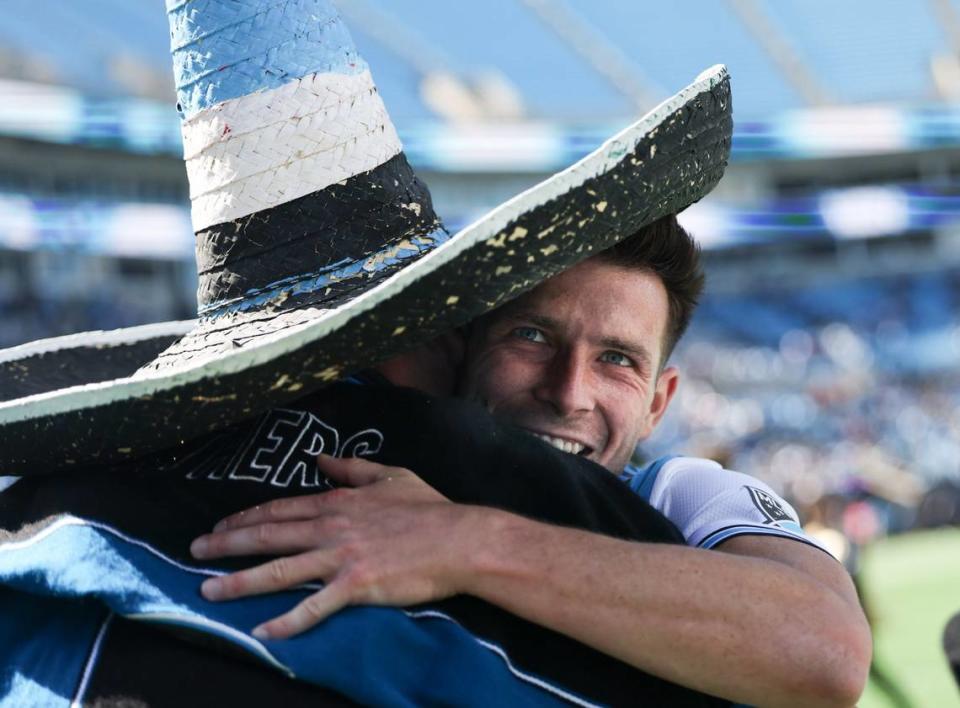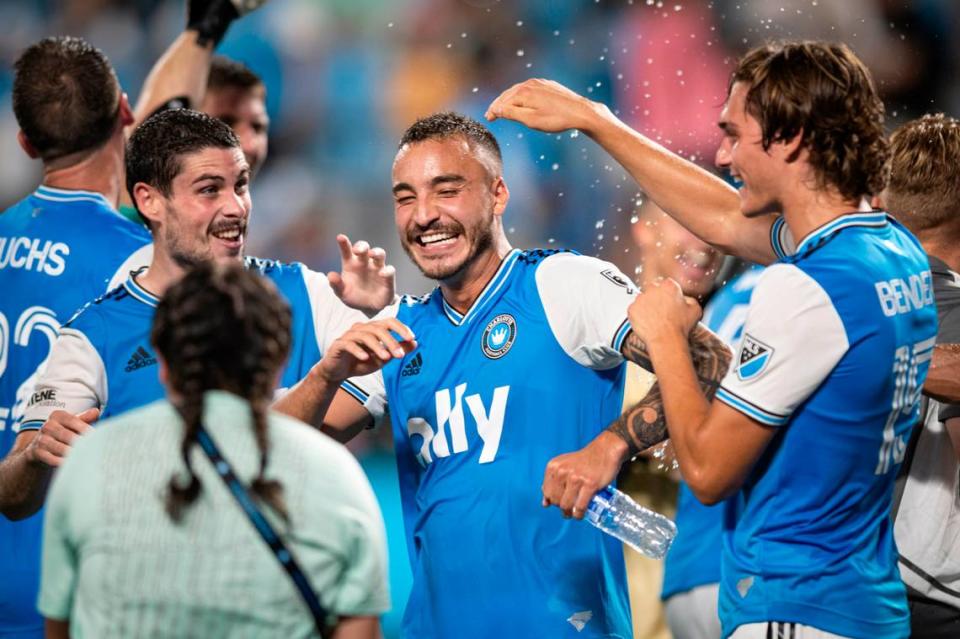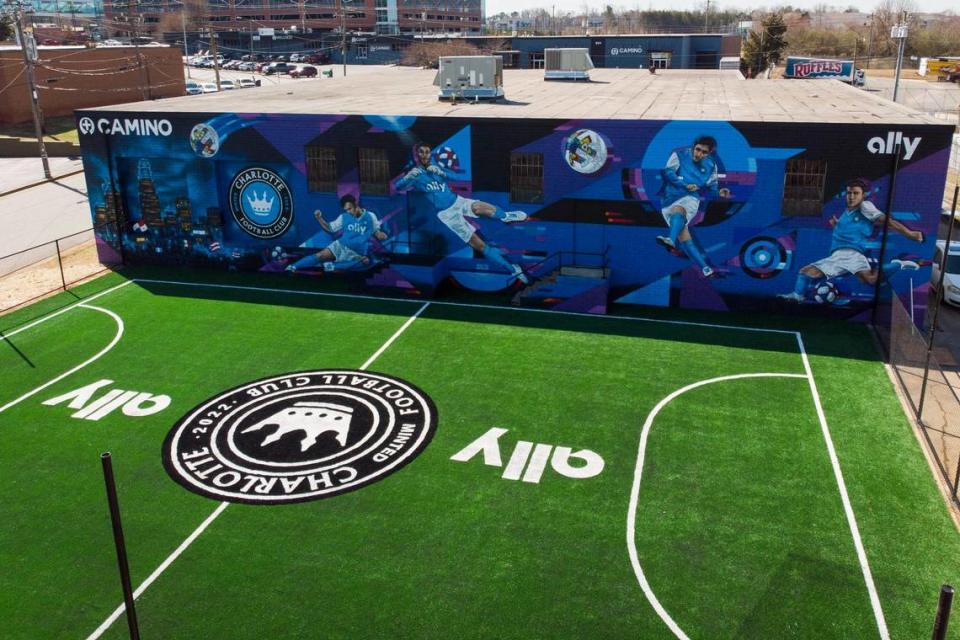Latino fans have helped deliver Charlotte FC its magic. Along the way, they found home.
Somewhere in the pre-match hoopla, you’ll find Hector Cortes.
He’s soaked in sweat. A Mexican national flag drapes down his back like a cape. He’s wearing a pair of powder blue-rimmed sunglasses and an iconic homemade Charlotte FC sombrero. When he stands, he’s an intimidating 6 feet, 5 inches with a build like a Carolina Panthers offensive lineman — but even now, as he sits at a peeling picnic table on a muggy August evening in uptown Charlotte, surrounded by friends and fans, he still maintains that larger-than-life look. He’s affable. Gregarious. The biggest man on campus.
They call him Sombrero Man.
“So this is it,” Cortes says. He’s beaming with pride as he turns and reveals the party around him.
On most days, the gravel parking lot off McNinch Street sits dormant, enduring noise pollution from nearby Interstate 77. But on this day, just hours before Major League Soccer’s newest team goes on to play and dismantle one of the league’s oldest in D.C. United, this lot plays host to the official pre-party that has come to define Charlotte FC matches. Cumbia music and other Latin sounds blast. Kids kick a rubber soccer ball over a volleyball net. Multiple generations of adults tune their drums before they boisterously march toward Bank of America Stadium — mixing and melding customs they’ve adopted from other parts of the world and creating something new.
“This represents everybody,” says Leo Gomez, another fan at the tailgate. “This is our team.”
Charlotte FC’s presence and impact on its city has been undeniable. You see it everywhere, from the team flags hung outside of bars in uptown, to the Charlotte FC shirts that permeate Carolina Panthers tailgates. The club has averaged an attendance of more than 35,000 per game in 2022 — second-most in the league — and it broke the MLS attendance record when it welcomed 74,479 fans on home-opening night.
When Major League Soccer announced its top-selling jerseys in the league, two Charlotte players — Christian Fuchs and Karol Swiderski — cracked the Top 10, marking the most successful and top-selling inaugural jersey launch in MLS Store history.
Yet of all the impacts this team has had on its city in Year 1 — which ends Sunday when the team plays its regular-season finale on the road against the New York Red Bulls — the one that might be most salient could be found on match days this summer, at the lot off McNinch Street.
It’s where you will find Cortes, who grew up in Guadalajara, Mexico, before moving to the United States in the 1990s and then to the Charlotte area in 2006. It’s where you will find Gomez, who grew up in Buenos Aires, Argentina, before moving to the U.S. in 2001 and then to the Charlotte area in 2010.
It’s where you will find fans with roots in Latin America who have helped deliver Charlotte FC its inaugural-year magic. Where you find people who, as a result of their fandom, have found a home.
“Trust me,” Cortes said, “all of the fans that you see in the supporters’ section… we are from different countries, from different parts of the world. And for whatever reason, we ended up here in Charlotte. And this is just my point of view, but one of the things that connect us back to our home countries is soccer. And now that we have a local team, it just fires us up. It’s just so amazing.”

The team Charlotte was waiting for
The Charlotte metro area — which includes Concord, Gastonia and parts of York and Lancaster counties just across the state line — had 2.66 million residents as of April 2020, nearly 18.6% more than in 2010. According to the U.S. Census Bureau data released this year, Charlotte ranks as No. 9 on the list of fastest growing populations in the country.
Mecklenburg County residents who identified as Hispanic or Latino — 169,922 — are driving that growth, as they have for decades: The number of Latinos in Mecklenburg grew by 52% in the past 10 years, 2020 Census data showed — the largest ethnic population growth in the county.
When you walk into Bank of America Stadium and see the flags of Latin American countries flowing in the air, bringing color and life to the supporters’ section behind the East end zone, you see not only a symbol of Charlotte’s recent evolution, but evidence that this is what the Latino community has been waiting for all along.

Longtime Charlotte broadcaster Claudio Bonus has certainly been waiting on it. Bonus began his career in Argentina but has covered Charlotte sports for Spanish-speaking media outlets for the past 16 years. He’s worked for ESPN Deportes Radio, Univision Deportes Radio and written columns for several newspapers. He’s also seen and documented all the major soccer-related events in the Charlotte area: World Cups, Gold Cups and more.
“I knew that a soccer team was necessary, and I was (and still am) convinced it would be successful, especially after the match between the Mexican National Team and Iceland in 2010, which was attended by 70,000 people, many of them Latinos,” Bonus told The Charlotte Observer by email. ”Every time I covered the MLS, listeners would ask when would Charlotte have its team.”
Bonus saw the joy Charlotte FC, which was announced in 2020 but didn’t begin its first season until 2022 due to the COVID-19 pandemic, brought to the city. He said he saw younger fans, often the children of immigrants, catch on quickly, with older generations of Latinos gradually boarding the Charlotte FC train.
Part of that is thanks to the various fan groups that have sprouted. Dozens of groups descend on the stadium or watch road matches in local bars/restaurants together. The Latino-oriented Blue Furia is among the most visible and passionate groups, with its flag-waving members singing, “!Vaaamos, vamos, vamos Charlotte; que esta noche, tenemos que ganar!” (Let’s go, Charlotte, because tonight we have to win.)
It also helps that the team has several players from Latin America on its current roster. Many of them were on the roster for the team’s first match: Guzman Corujo of Uruguay was one of the first players Charlotte FC signed. Joseph Mora of Costa Rica, Jordy Alcivar and Alan Franco of Ecuador, Yordy Reyna of Peru, Vinicius Mello of Brazil, and Daniel Rios of Mexico have spent all season with Charlotte FC. Andre Shinyashiki, a fan-favorite who joined mid-season and signed a multi-year extension with the team in August, was born in Sao Paulo, Brazil.

Rios, in fact, notched the first hat-trick in club history when he scored four goals against Philadelphia on Oct. 1. He enters Sunday’s season finale Sunday as the second-leading goal-scorer on the team with seven, only three behind striker Swiderski.
“I really believe, and I’ve seen it, that soccer is growing a lot in America, too,” Rios told the Observer. “It’s good to have different communities, different cultures, feeling a part of this, and it’s amazing to have a chance and the honor to represent them.”
He added: “To be honest, everything we do on a game day, that the fans attend and support, is for them.”
Sombrero Man — who is also a fixture at Hornets games (which began when he started following Mexican-born former Charlotte Bobcat Eduardo Najera) — said being able to communicate with the players in his native language Spanish is something special.
“Not only is the futbol team there for Latinos, but the fact that we have some players who are Latinos or Hispanics,” Cortes said, “and the fact that as a fan, a Latino or Hispanic fan, can yell at the players and speak to the players in their native language, it’s awesome.”

Charlotte FC cultivated roots by design
The team itself knew how important building a robust, diverse fan base would be. Where the team showed up, where it put its resources, was “very intentional.”
Charlotte FC president Joe LaBue said that cultivating the fan base at large was a calculated process that began back when David Tepper purchased the Panthers in the summer of 2018. When Charlotte hosted Gold Cup matches and International Champions Cup matches at the stadium, there was a team from Tepper Sports and Entertainment on the ground, asking fans the most basic of questions. Who do you support? Why do you support them? Would you support a Major League Soccer team here in Charlotte?
There was also a group on the ticketing side learning what soccer fandom at its purest looked like, learning how to accommodate it. That’s where TSE linked up with some of the supporters with whom it still remains in contact today. Some were leaders from Pancho Villa’s Army, the supporters group for the Mexican National Team.
“The reason why were able to engage with (Panchos) is because they needed our help getting tifos in, getting flags into the stadium for the Mexican National Team matches,” LaBue told The Observer. “So being on the ticketing side, we were involved in mediating and assisting stadium operations, with making sure that Pancho Villa’s Army, for example, was taken care of.”

Reaching the community
That was just the beginning of an extensive Charlotte FC grassroots campaign, one of informal and formal connections.
Among the more formal community outreach plans: The team has put on block parties, including one earlier this month to celebrate Hispanic Heritage Month. The team has worked with the Latin American Chamber of Commerce. The team has installed five “mini-pitches” around the city, at local elementary schools and businesses. One was at the Camino Health Center, a bilingual and multicultural health center meant to assist Charlotte residents. That field is framed by a beautiful blue mural on one of the facility’s walls.
Among the more informal community outreach plans: Shawn McIntosh, the team’s chief fan officer, regularly texts “community captains,” people throughout Charlotte and North Carolina who have their ears to the ground, who know when and where Charlotte FC should show up.
”(The community) is really helping steering us as a club,” McIntosh said.
There are still ways Charlotte FC can show how much it values the Latino community, Bonus said. Among his suggestions: directly disseminating information in Spanish, and having a “voice of advocacy” in the club’s leadership or at the management levels, someone who has first-hand experience and “fully understands the dynamics, the preferences, the language and the traditions of the Latinx fans.”
Bonus said Charlotte FC has embraced and empowered the community he covers nonetheless. And it could do even more.
“Many immigrants have lived in Charlotte for decades but still don’t feel Charlotte is their home,” Bonus wrote. “I believe Charlotte FC has the potential of inspiring immigrants in general, not only Latinos, to develop a sense of belonging to the city they live in.
“Feeling a sense of community and representation is crucial for anyone’s well-being and the community as a whole. I believe Charlotte FC could provide some of that.”

Living, singing and changing together
If you’re tasked with distilling the legacy of Charlotte FC’s season on the pitch into one moment, the fans again stand at the center. It was on March 5, minutes before the first home game.
Cortes — Sombrero Man — remembers it well. He was on the field, he said, a perk of working closely with the team to get its inaugural year off the ground.
As the singer for the national anthem began her second breath of notes, the speaker system cut out. But the song, beautifully carried on by everyone else in the stadium, went on.
“I was on the field,” Cortes said, “and I saw a lot of people crying. A lot of adults, crying.”
Said Rios: “I wanted to record it in my memory, in my mind, so when I get old I can have the pressing memory of what was that day.”
That moment, which anyone can relive on Charlotte FC’s YouTube page, went viral. It sparked an enduring tradition: Now the guest singer of the national anthem for Charlotte FC home matches sings the first few lines and extends the microphone to the rest of the crowd, which finishes the song.
So much has changed since that home-opening match: The team has fired its inaugural coach, traded or moved a few opening-day starters, changed practice facilities and made a late-season playoff push.
But as the players and circumstances changed, the team’s most enduring tradition involved people from all walks of life — from Latin America and beyond — singing a song that declared that Charlotte, that the United States, was their home.
“I saw people who were Latinos, who were Hispanics, who were of different cultures, all singing it,” Cortes said.
“That night was magical for sure.”
And along the way, those supporters who were there on that magical night — and those who have since joined the masses — have found a community. A home.
“We now have something we can root for,” Cortes said. “And we can call it our own.”

